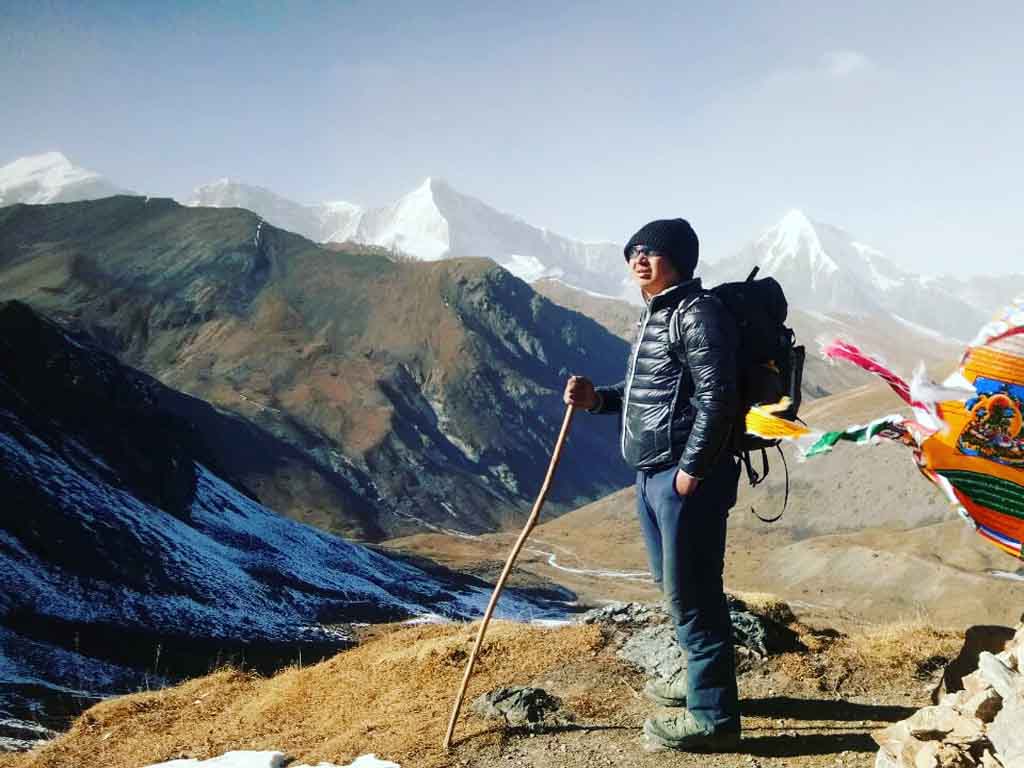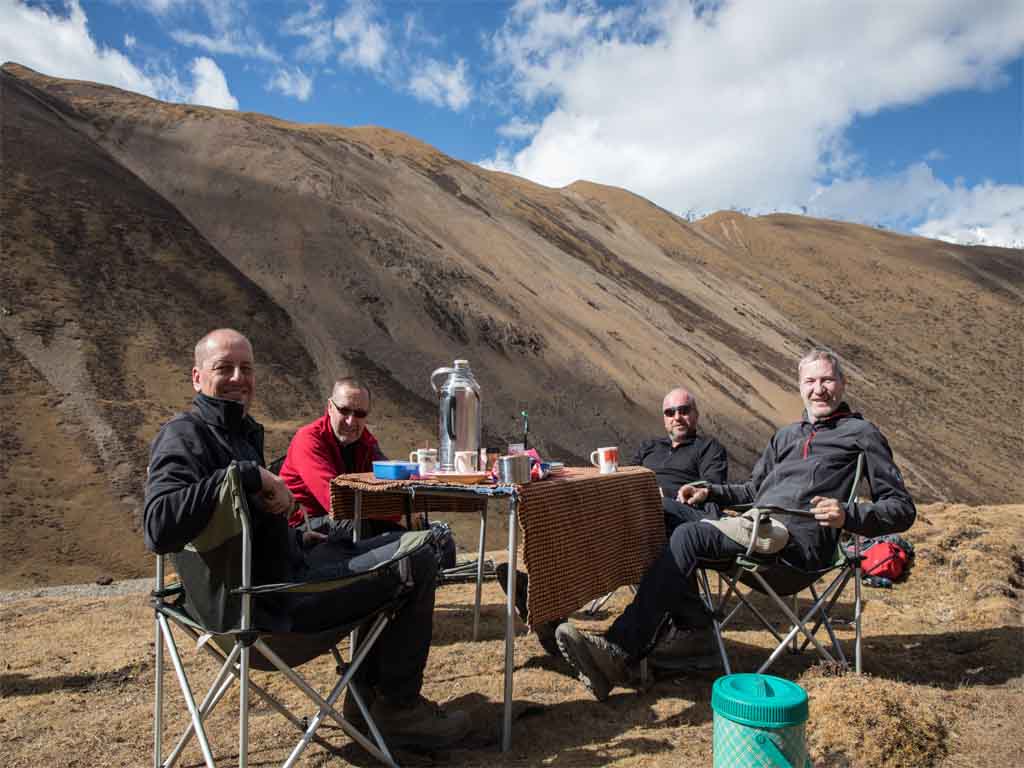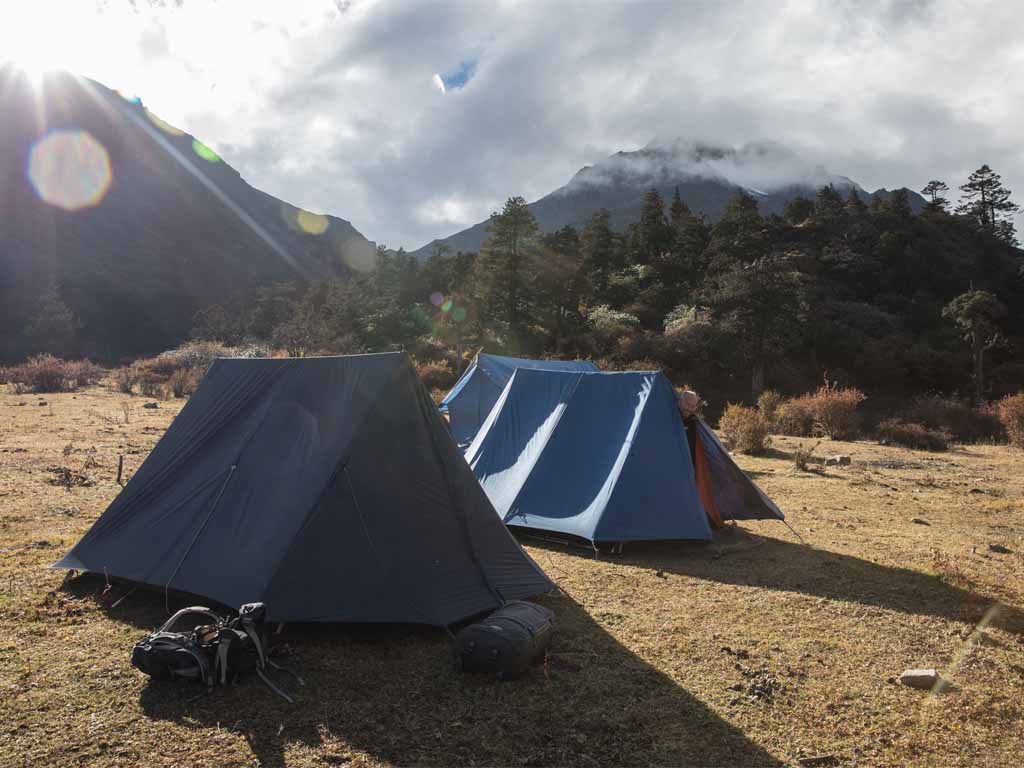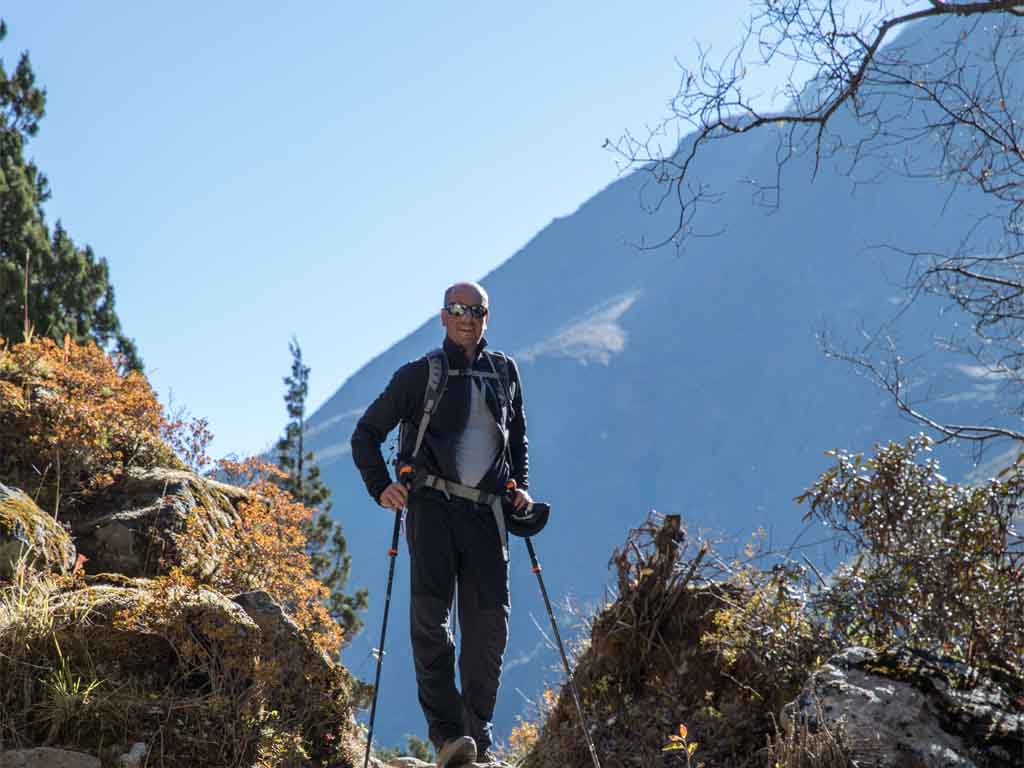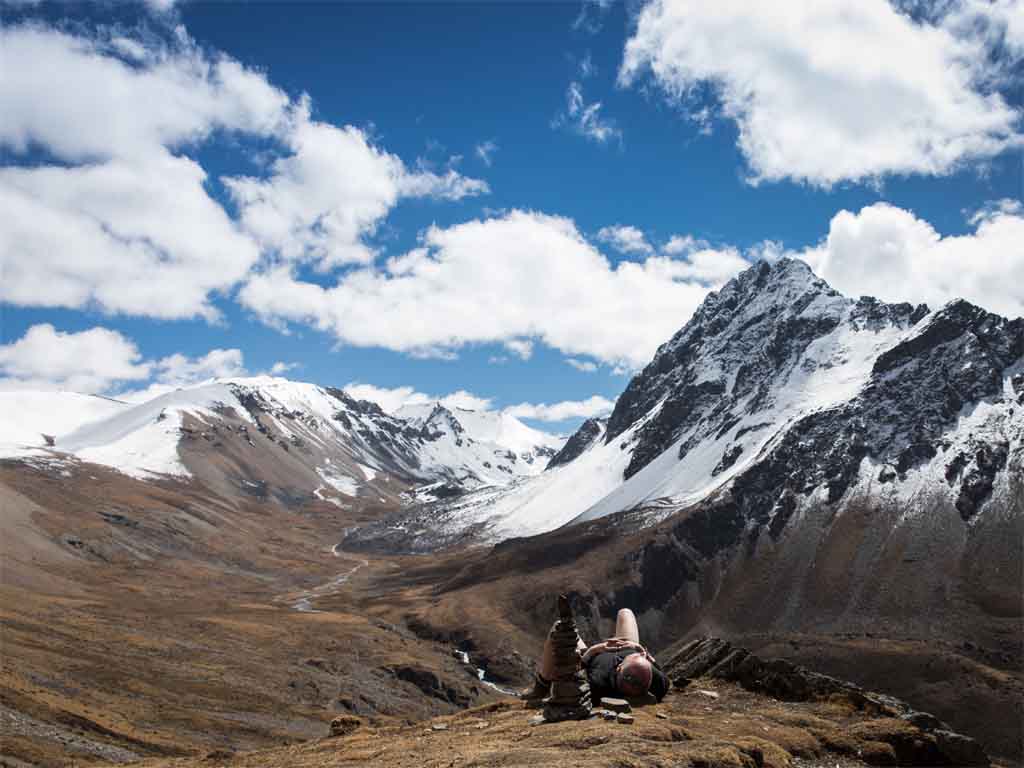Laya gasa trek
The five five days of Laya Gasa Trek follows the same route as the Jumolhari Trek. Along the way you can get the good views of snow capped peaks like Mountain Jomolhari, Jichu Drake and Tsheringma.
On the sixth day the path splits towards Lingshi via a campsite at Chebisa ; a charming village adorned with beautiful waterfall of Crystal clear water.
Things To See In Laya Gasa Trek
If you are lucky you will spot some interesting wildlife along the way, including Blue Sheep and the national animal of Bhutan, Takin.
Laya Gasa trek takes you through this remote mountain region . It passes villages inhabited by Layaps with their own traditional habits, culture and style of Dress. It will be a once in a lifetime experience. Aside from that, it offers the trail weary hiker a wonderful reward at its end: a well deserved soak in relaxing natural hot spring in Gasa.
The Laya Gasa trek terrain is challenging, to say the least. In fact it’s among the more difficult trek in Bhutan due to the high altitude and steep ascents and sharp descents along the route. The best month to take up this challenge are April to June and mid-September to mid-November. For those who persevere , the picturesque views of snow covered peaks, the clear, star-lit night skies, and the opportunity to commune with nature are ample rewards.
Ten years ago Laya Gasa Trek began from Drukgyal dzong in Paro but now a farm road from Drukgyal cuts off the first day trekking in Bhutan. Today you can drive to what used to be the first night campsite near the outpost of Shana. Ten minutes after leaving the army checkpoint, where trekkers are required to present their permits, you reach Baily bridge at Shana. Don’t be alarmed by large number of camp staff and crew who will join you at this point; to ensure your safety, comfort and happiness in the rugged Himalayan Outdoors.
![]() Duration: 13 Nights/ 14 Days
Duration: 13 Nights/ 14 Days
![]() Location:
Location:
Day 1: Sharna Zampa To Soi Thangkha
Sharna Zampa to Soi Thangkha
22KM | 7-8 HOURS | 900M ASCENT | CAMP ALT 3550M
Just like the previous day, we will be following the trail following the Pachhu (Paro river). We will be ascending and descending through pine, oak and spruce forests. You will reach at Shingkharap after 2 hours of hiking and crossing several streams. This is a stone house at 3110m. You will then cross the bridge towards the left side of the river where you will be served a hot lunch. A little walk ahead is the trail junction. The left road is an old trade route to Tibet and the right route leads to the wooden bridge. We will be taking the latter route. After climbing through rhododendron forests and finally crossing the bridge again, we reach our camp at 3550m, which is amidst beautiful meadows.
Day 02: Soi Thangthangkha To Jangothang Base Camp
Soi Thangthangkha to Jangothang base camp
18KM | 5-6 HOURS | 600M ASCENT | CAMP ALT 4100M
Today is not a long trekking day but it will involve a significant gain in altitude as your trail goes above tree line. As you take the path that ascends from our camp you will be brought to an army camp. Then you will follow the river above the tree line as well as enjoying the spectacular view of the surrounding mountain peaks. After walking through a very muddy section and passing a mani wall you will enter yak country. Inside a yak herder’ camp you will be served a hot filling lunch. After lunch, we walk past yak herder settlements of Soe and Takethang. Some common crops that people grow here are barley, potatoes and turnips. After your lunch, you will walk across a plateau and up a stream bed. You will pass Dangochang village to the beautiful campsite of Jangothang at an altitude of 4,100m. From here, the views of Mount Jumolhari and Jichu Drake will take your breath away.
Day 03: Jangothang Acclimatization And Exploration
Jangothang acclimatization and exploration
Today, you will do a four hours long acclimatization hike to the north of your camp. There isn’t really a trail but you will climb on an open and endless slope till you see the view of Mt Jichu Drakye (6989m). You can hike further up to 4895m (higher than Mount Blanc) to see the amazing view of Mount Jumolhari. You are likely to spot rare blue sheep, Himalayan rhubarb, griffon vultures, golden eagles and the national flower – the blue poppy. In the foreground below the colossal Mount Jumolhari and its neighboring mountain, Jichu Drake is the Jangothang base. It is a flat grassy land with the ruins of an old fortress on a hillock. It is highly recommended for all trekkers to halt here as most people show signs of mountain sickness at this altitude. You will have the option to hike or to simply rest in camp. Both ways, it will be a very memorable day.
Day 04: Jangothang To Lingshi
Jangothang to Lingshi
19KM | 6-7 HOURS | 780M ASCENT | 820M DESCENT | CAMP ALT 3850M
Today’s trail follows the stream for half an hour and crosses the bridge to the right side. You will then start to climb up to the first ridge where you will be greeted by a breathtaking view of Jumolhari (7314m), Jichu Drake (6989m) and Tshering Gang (6789m). You will then be walking on an almost flat track for sometime towards the valley and then you will have to climb to Ngye La pass at 4,750m. After the pass, it is a gradual descent to the camp. You will get to enjoy the spectacular panoramic view of the peaks here and the Lingshi Dzong. If time permits, you can take a detour to this tiny fortress that is sits on a hilltop overlooking Lingzhi village. For centuries, Lingzhi Dzong was a way station for weary Buddhist pilgrims and was a defense fort against Tibetan and Mongol invaders. You will camp today at an altitude of 3950m.
Day 05: Lingshi To Chebisa
Lingshi to Chebisa
12KM | 5-6 HOURS | 160M DESCENT | CAMP ALT 3950M
Perched on a hilltop with breathtaking views of green hills, meandering rivers and magnificent peaks is the Lingshi Dzong. For centuries, Lingzhi Dzong was a way station for Buddhist pilgrims. It was also a defense fort against Tibetan and Mongol invaders. Today is an easy day filled with pleasant walks through villages and yak herders’ camp. After lunch, a short walk will take you to Chebisa, a charming little village adorned with a beautiful crystal clear waterfall. You will camp by the side of a stream at an altitude of 3,850m.
During the festival, visitors can witness The traditional offering of Buelwa (Gift offering) with Auley (traditional epic poem/song recitation tradition originated from Zhabdrung Rinpoche days) that begun during Zhabdrung Rinpoche’s reign in showing loyalty and respect by the community of Laya is being offered for dynamic and visionary leadership of our successive monarchs.
Variety of cultural programs will be performed by Layaps. Competition such as traditional songs and dances.
The various competitions on highland animals including the Yaks, horses and Mastiffs will be held.
The festival consists of series of stalls ranging from local based yak produce to highland technology, highland agriculture technology, medicinal herbs & plants and others. You can do some filming here as well
Later we will explore Laya valley, one of the most remote place in the planet. The whole settlement has about 110 houses. The people of Laya have their own dialect, customs and distinct dress. The women keep their hair long and wear conical bamboo hats with spike at the top. Cordyceps sinesis which is an insect parasite fungus having high commercial demand due to its high medicinal value is also found here.
Overnight at Camp at Laya
Day 06: Chebisa To Shoumuthang
Chebisa to Shoumuthang
17KM | 6-7 HOURS | 570M ASCENT | 290M DESCENT | CAMP ALT 4130M
You will begin your trek with a steep climb up a ridge to Gogu La pass (4440m) which will take nearly four hours. It is common to spot rare blue sheep on the rocks near the top of this pass. After the pass you will make a descent in your route where you will pass through rhododendron bushes to a lunch stop. In the afternoon you will continue to walk along the trail with scattered ascents and descents. After crossing the stream, walking through rhododendron forests and yak herders camp, we arrive at Shakepasa at 3980m. After this point, you will be climbing steeply up to the northern side of the valley and passing by a few yak herders’ camp. We will then arrive at our camp located beside a stream at an altitude 4,250m.
Day 07: Shoumuthang To Rogluthang
Shoumuthang to Rogluthang
17KM | 6-7 HOURS | 570M ASCENT | 290M DESCENT | CAMP ALT 4130M
Today the trek begins by you walking through edelweiss bound trail and then a climb to Jari La pass at an altitude of 4,700m. The snow capped peak visible to the south-east is Kangbum at 6526m. You will then descend to Tsarijathang valley. This valley is the summer residence of rare Himalayan Takins (national animal of Bhutan). From here on you may have to cross streams without a footbridge because in most cases these bridges are washed away. After crossing the stream, to the left the trail ascends till you reach Robluthang. It is a rocky meadow camp at an altitude of 4,200m.
Day 08: Robluthang To Lingmithang
Robluthang to Lingmithang
19KM | 7-8 HOURS | 850M ASCENT | 870M DESCENT | CAMP ALT 4140M
Today will be an exhilarating day as you will cross the highest pass in our entire trek. You will climb all the way up through boggy patches. As you follow this trail you’ll be crossing streams and spotting marmot holes and moraine. You will then reach the top of Shingchen La pass (5005m). You will be greeted with the view stunning view of the snow-covered Gangchenta or the Tiger Mountain (6,840m) filling the northern horizon. After taking in the view you will descend through a rough rocky trail following the moraine river valley to Kango Chhu River. You will find that the path is quite narrow and you may be expected to cross a stream again and get yourself wet. After a fresh walk through cedar forests you will finally arrive at Lingmethang (4,140m). Lingmithang is a beautiful campsite, with scattered meadows by the river with Tiger Mountain (Gangchenta) towering behind your campsite.
Day 09: Lingmithang To Laya
Lingmithang to Laya
10KM | 3-4 HOURS | CAMP ALT 3850M
In the morning you will wake up to a superb view of Gangchenta peak. The walk to Laya is very pleasant with wonderful views. You will pass through a damp forest, filled with moss and singing birds. It is a pretty long walk through this uninhabited valley. You will also see a waterfall as you follow this trail. As you walk further, you will find yourself at a junction. The upper route will bring you to fields spotted with stone houses. Arrive at Laya village, the second highest settlement in the country, at an altitude of 3,800m.
Day 10:Rest Day At Laya
Rest day at Laya
Today is a day you can temper to your taste. Explore Laya village and go visit any of the houses around. Hospitality is a big part of Bhutanese tradition. Even to a perfect stranger, traditional Bhutanese hospitality is extended and a cup of tea and Chang (local, wine) is always offered. You will notice that the people in this valley are very interesting especially their attire. Women in particular have very conspicuous attire, wearing conical bamboo hats decorated with turquoise and silver ornaments.
Day 11: Laya To Chamsa
Laya to Chamsa
19KM | 6-7 HOURS | 50M DESCENT | CAMP ALT 3800M
Today you will descend to the army camp and join the Mo Chhu (Mother River of Punakha). You will then follow the river till you cross the bridge. After you cross the bridge you will be making several ascents and descents through juniper and fir forests. You will eventually reach the camp at Chamsa at an altitude of 3,800m.
Day 12: Chamsa To Gasa Tshachu
Chamsa to Gasa Tshachu
19KM | 6-7 HOURS | 300M ASCENT | 1200M DESCENT | CAMP ALT 2900M
After walking for about half an hour over flat land you will get to Bari La pass. From this point the trail decreases in altitude all the way to Gasa Tshachu (Hot water spring). On the way, you may spot Satyr Tragopan, Himalayan Monal, and Blood Pheasants. You will be camping at Gasa village at an altitude of 2,700m.
Day 13: Gasa Tshachu Rest Day
Gasa Tshachu rest day
Gasa Tshachu (Hot spring) is the place to take a well awaited rest. You can visit the village and the Gasa Dzong. The Dzong was built in the 17th century by the first religious leader of Bhutan, Zhabdrung Ngawang Namgya. It was built to protect the valley against Tibetan invaders. After visiting the Dzong, make a descent to Gasa Tshachu (hot spring) to enjoy the hot bath in one of the pools. The Gasa Tsachu is one of the most popular hot springs in Bhutan.
TOUR HIGHLIGHTS
Endeavor on one of the most beautiful trekking adventures of Bhutan
Explore the gorgeous alpine meadows, high mountain passes and dense subtropical forest.
Enjoy the magnificent views of the Mount Jomolhari (7,326 m); Jichu Drakey (6,662 m) and Tsherimgang (6789 m).
Navigate through high Mountain Passes of Neyle La Pass at 4,700 meters & Singchen La Pass at 5,000 meters.
Experience the remote and unique nomadic culture of Laya & Lingshi
You will be able to spot many Blue Sheep, Himalayan Marmots, and Takin; the national animal of Bhutan and yaks. If you are lucky you may also be able to see rare Snow Leopard.
Camp at Jomolhari base and absorb the serene silence of the Mountains
Mid Spring is a good time to spot different species of Rhododendron
You may also be able to see the alpine Blue Poppy, the national flower of Bhutan
Relax your muscles at the Gasa Hot Spring at the end of the Trek
PACKAGE COST FROM
$ 3810
Package cost :
USD 3810 per Person basis on double sharing basis
Single Room Supplement:
USD 50 per Person and per Night
PACKAGE INCLUSION
Sustainable Development Fee to the Government of Bhutan which goes towards the development of schools. hospitals. etc.,
Bhutan Visa
Accommodations in 3- star properties. (Can be upgraded to 4 & 5-star with additional Premium)
All Meals (Breakfast, Lunch & Dinner)
Certified English Speaking Bhutanese Guide.
All ground transportation
All internal taxes and charges including Entry Fees
Mineral Water while traveling
Complimentary from company:
Traditional Hot Stone Bath
PACKAGE EXCLUSION
Airfare (can be arranged with us)
Travel Insurance
Any Expenses of Personal Nature
Tips for the guide and driver


